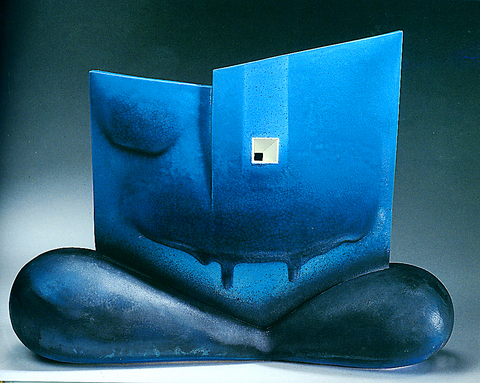The Yingge Ceramics Museum(鶯歌陶瓷博物館) in Taipei County is presenting for the first time one of the largest displays of contemporary ceramic artworks from North America. The National Council of Education for the Ceramic Art (NCECA) has lent the museum 125 pieces from 67 North American contemporary ceramic artists. The exhibition, titled Diverse Domain: Contemporary North American Ceramic Art,(複調多音北美當代陶藝展) will run until Oct. 2.
The exhibitions spans three floors of the museum, with the works of each artist placed in no particular order.
The curator, Michele Conroy said, "The NCECA's purpose is to reflect a true and honest picture of North American ceramic art, which is diversified instead of being unified. Diversity and pluralism are central to contemporary American society and culture. Each work speaks of its own and no one overriding principle. We aim for each individual artist's personal expression, not just the popular style."

PHOTO COURTESY OF THE YINGGE CERAMICS MUSEUM
Visitors to the exhibition can find many North American porcelain, stoneware and earthenware pieces, with influences drawn from a variety of sources, including nature, society, and history.
To create an accurate portrayal of North American ceramic art the art show is intended to "include artists representing a full range of aesthetic and stylistic approaches, from utilitarian pottery to installation sculpture, early career artists as well as established artists, an equal representation of female and male artists, and artists somewhat evenly dispersed geographically," Conroy said.
According to Kuo Yih-wen (郭義文), a professor of ceramics from the University of Northern Illinois and an abstract ceramic sculpture artist, contemporary ceramics can be categorized into two groups. The first group is studio pottery, which includes both handmade production pottery and one-of-a-kind vessel making. The second group is ceramic sculpture, which can also be divided into two subgroups -- representational and abstract. Representational sculptures consist of forms from nature, whereas abstract sculptures aim for geometric, organic or architectonic shapes.
The exhibition consists of representational sculptures from artists such as Tom Bartel's Death and Life Figure, with somber-faced figures eerily staring, while Justin Novak's Disfigurines has figures slicing themselves open with scissors or licking blood from wounds. Esther Shimazu's bald, rotund, naked stoneware women smile alongside youngsters playing ping-pong.
The NCECA, headquartered in Denver, Colorado, is an organization comprised of over 5,000 members from 25 countries. Dedicated to promoting ceramics since its formation in 1966, its annual conference is the world's largest event devoted to ceramic arts. Susan Filley, NCECA's president, hopes that this exhibition will foster national differences.
The NCECA has also contributed to exhibits in China and South Korea and has awarded prizes to ceramic artists. A statement made by the museum's projector coordinator Chen Miao-feng (陳妙鳳) best shows the spirit of Diverse Domain.
This exhibition, she said, uses Diverse Domain as "the topic to interpret the independence of North American artists' creative consciousness and the diversities of the styles of the works.... Every exhibitor can speak in his or her own voice while coexisting in this diversified age."
Performance notes:
Where: The Yingge Ceramics Museum at 200 Wenhua Rd, Yingge Township, Taipei County (
What: Diverse Domain -- Contemporary North American Ceramic Art
When: Now until Oct. 2.
Time: 9:30am to 5pm on weekdays and 9:30am to 6pm on weekends. The museum is closed on Mondays.
General admission: NT$100.
For more information, call (02) 8677 2727, or visit http://www.ceramics.tpc.gov.tw

June 2 to June 8 Taiwan’s woodcutters believe that if they see even one speck of red in their cooked rice, no matter how small, an accident is going to happen. Peng Chin-tian (彭錦田) swears that this has proven to be true at every stop during his decades-long career in the logging industry. Along with mining, timber harvesting was once considered the most dangerous profession in Taiwan. Not only were mishaps common during all stages of processing, it was difficult to transport the injured to get medical treatment. Many died during the arduous journey. Peng recounts some of his accidents in

“Why does Taiwan identity decline?”a group of researchers lead by University of Nevada political scientist Austin Wang (王宏恩) asked in a recent paper. After all, it is not difficult to explain the rise in Taiwanese identity after the early 1990s. But no model predicted its decline during the 2016-2018 period, they say. After testing various alternative explanations, Wang et al argue that the fall-off in Taiwanese identity during that period is related to voter hedging based on the performance of the Democratic Progressive Party (DPP). Since the DPP is perceived as the guardian of Taiwan identity, when it performs well,

A short walk beneath the dense Amazon canopy, the forest abruptly opens up. Fallen logs are rotting, the trees grow sparser and the temperature rises in places sunlight hits the ground. This is what 24 years of severe drought looks like in the world’s largest rainforest. But this patch of degraded forest, about the size of a soccer field, is a scientific experiment. Launched in 2000 by Brazilian and British scientists, Esecaflor — short for “Forest Drought Study Project” in Portuguese — set out to simulate a future in which the changing climate could deplete the Amazon of rainfall. It is

The Taiwan People’s Party (TPP) on May 18 held a rally in Taichung to mark the anniversary of President William Lai’s (賴清德) inauguration on May 20. The title of the rally could be loosely translated to “May 18 recall fraudulent goods” (518退貨ㄌㄨㄚˋ!). Unlike in English, where the terms are the same, “recall” (退貨) in this context refers to product recalls due to damaged, defective or fraudulent merchandise, not the political recalls (罷免) currently dominating the headlines. I attended the rally to determine if the impression was correct that the TPP under party Chairman Huang Kuo-Chang (黃國昌) had little of a